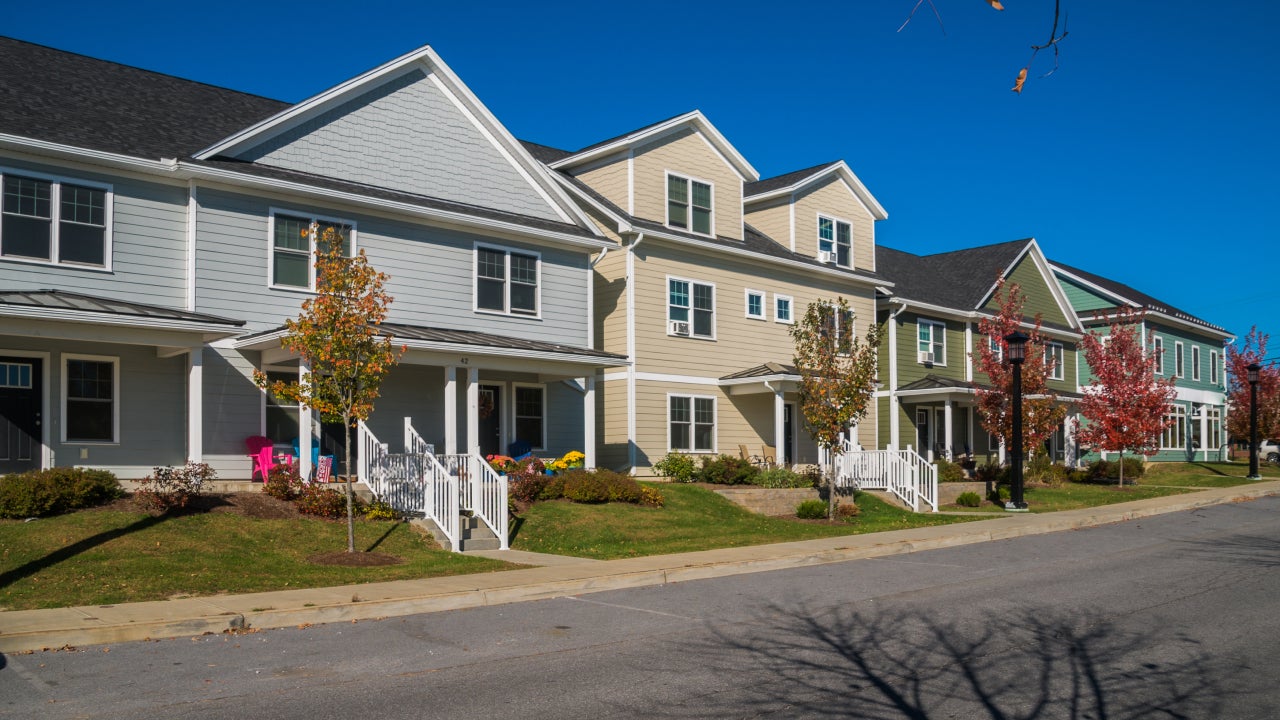USDA loans: What are they and am I eligible?




Key takeaways
- USDA loans are government-backed mortgages for borrowers buying in eligible rural areas.
- These loans come with lenient credit score requirements, and they don’t require a down payment.
- USDA mortgages also come with income and sometimes loan limits that vary by location.
What is a USDA loan?
A USDA home loan is a type of government-backed mortgage, available to low- and moderate-income borrowers buying in certain rural areas. Also referred to as rural development or RD loans, they’re part of a national program created by the U.S. Department of Agriculture. While often used by first-time homebuyers, USDA loans are available to any qualified borrower who meets income and property eligibility requirements.
Who is eligible for a USDA loan?
To be eligible for a USDA loan, you must:
- Be a U.S. citizen or permanent resident
- Buy in a rural area designated by the USDA
- Occupy the home as your primary residence
- Meet income requirements based on the type of USDA loan you’re applying for
Eligible properties
The easiest way to find out if a home is in a USDA-eligible area is to check the USDA website. Homes purchased with USDA loans must be located in eligible rural areas.
Income limits
The USDA loan program is geared toward low- and moderate-income homebuyers. Applicants must meet income limits, which vary by family size, metro area and loan program. In more expensive areas, the income ceiling is higher: Sometimes you can earn as much as six figures. You can check income limits for your county and household size using the same property eligibility tool on the USDA website.
To prove income, you’ll need to provide the lender with documentation such as:
- Paystubs
- Tax statements (W-2s, 1040s and 1099s)
- Evidence of other income, such as alimony, child support payments or Social Security benefits
- Statements for bank and investment accounts
Credit score
The USDA doesn’t impose a blanket credit score requirement for all borrowers, but typically, USDA-approved lenders look for a score of at least 640.
Types of USDA loans
There are three different types of USDA loans, each with different purposes and target borrowers.
USDA guaranteed loans
The USDA guaranteed home loan program — officially known as Section 502 Guaranteed — allows approved mortgage lenders to provide 30-year fixed-rate loans to borrowers in USDA-eligible locations. It’s called a “guaranteed loan” because the USDA agrees to reimburse up to 90 percent of the loan to the lenders in the event the borrower defaults on the mortgage.
Along with buying a home in a USDA-approved area, your household must earn no more than 115 percent of your area’s median income (AMI). You can find income limits for your market using this tool.
USDA direct loans
Also known as Section 502 Direct, these are low-rate home loans for individuals in rural areas in need of adequate housing. Unlike USDA guaranteed loans, you’ll apply for a direct loan through the USDA’s Rural Development Service Centers — not through a lender.
Direct loans are available only to households with low and very low incomes — you can view income limits here — who are “unable to obtain a loan from other resources,” according to the USDA. There’s also a limit on how much you can borrow, ranging from $419,300 to $970,800, depending on the county where the home is located. You can view area loan limits here.
Direct loans have a fixed interest rate, currently 5.00 percent, or as little as 1 percent if you qualify for payment assistance. The loan terms range up to 33 years, or 38 years for very low-income borrowers.
USDA repair loans and grants
The USDA repair loan program, also known as Section 504 Home Repair, is similar to the direct program in that it caters to low-income individuals. However, its loans are intended to help owners repair and improve their homes, and the maximum amount is $40,000. The program also offers grants to very low-income homeowners aged 62 or older to help remove hazards in their residences; these are capped at $10,000.
How to apply for a USDA loan
- Check your eligibility. Use the USDA’s property and income eligibility tools to determine if you and the area you want to live in qualify.
- Choose your loan. Decide whether you’ll apply for a guaranteed loan through a private lender or a direct loan through a USDA Rural Development office.
- Submit your application. Provide documentation of your income, assets and debts and undergo a credit check.
- Get preapproved. If you meet the qualifications, you’ll receive a preapproval letter showing how much you can borrow.
- Start your home search. Begin looking for a home located in a USDA-eligible area.
USDA loan fees
USDA mortgages come with two fees:
- Upfront guarantee fee: The upfront guarantee fee this fiscal year is 1 percent of the loan amount. For example, for a $100,000 loan, this fee would be $1,000. This fee can often be rolled into the mortgage instead of paying it out of pocket.
- Annual fee: The annual fee is 0.35 percent of the loan amount. A $100,000 mortgage, for example, would have a $350 payment each year for the life of the loan.
Both of these fees are charged to the lender, who then usually passes the cost on to the borrower. These fees keep USDA loans subsidy-neutral, which means that any losses incurred by the program are paid for by these fees instead of taxpayer dollars. Depending on the needs of the program, the fees can change annually.
How much does it cost to get a USDA loan?
Along with the USDA fees listed above, you’ll need to cover regular mortgage costs. These may include:
- Origination fee: Many lenders charge an origination fee on mortgages, regardless of loan type. The fee usually costs between 0.5 and 1 percent of the amount you’re borrowing.
- Title insurance and services: When you buy a home with a mortgage, you’ll need to pay for a title search and the lender’s title insurance policy. The cost varies depending on the closing attorney or settlement or title company you use.
- Processing or underwriting fees: In addition to, or sometimes in lieu of, an origination fee, some lenders charge a “processing” or “underwriting” fee. This cost covers the expense of underwriting your loan application.
- Credit report fee: Many lenders charge a small fee to run a credit check.
- Appraisal: You’ll pay for the home appraisal before the lender can approve your loan. A home appraisal costs an average of $358 in 2025, according to Angi.
- Discount points: Many lenders let you pay a one-time fee to lower your loan’s interest rate. One point costs 1 percent of the amount you’re borrowing.
USDA loan rates
As of July 1, 2025, the current rate for a USDA Single-Family Housing Direct Loan is 5.00 percent. This is well below the national average for a conventional 30-year mortgage loan, which hovers near 7 percent at the time of this writing.
USDA guaranteed loans, which are available to more borrowers, have rates more comparable to conventional loans. A lot depends on the lender, so shop around.
Pros and cons of USDA loans

Pros
- No down payment required
- No formal loan limit for guaranteed loans
- Seller can pay the closing costs
- Available for both purchasing and refinancing
- Low, fixed interest rates for direct loans

Cons
- Property must be in designated locales
- Must use the home for a primary residence
- Buyer's income can't exceed a certain amount
- Upfront and annual fees
- Loan size can be limited (direct loans)
How do USDA loans compare to other types of loans?
USDA loans aren’t the only type of mortgage out there. If you’re not eligible for a USDA loan, you might be for an FHA or VA loan, or even a conventional loan. Here’s an overview of some key differences between these types of loans:
| USDA loan | Conventional loan | FHA loan | VA loan | |
|---|---|---|---|---|
| Credit requirements | None, but 640 is standard | 620 | 580 (500 if you put at least 10% down) | None, unless the lender requires it |
| Debt-to-income (DTI) ratio requirements | Up to 41% | Up to 45% | Up to 50% | Up to 41% |
| Minimum down payment | None | 3% (20% to avoid private mortgage insurance) | 3.5% | None |
Should you get a USDA loan?
If you’re qualified for a USDA loan, you’ll definitely want to explore the option.
“USDA loans are best for people who want to live in a rural or suburban area but don’t have extra cash saved up for a down payment,” says Jake Vehige, President of Mortgage Lending at Neighbors Bank. “We especially see a lot of first-time buyers benefit from the program since there’s no down payment requirement and the rates are often really competitive.”
You’ll get the best deal with a USDA direct loan, but these have strict eligibility requirements. And then, of course, there’s the extra paperwork and lengthy approval process that often accompanies government-guaranteed mortgages.
FAQ
Why we ask for feedback Your feedback helps us improve our content and services. It takes less than a minute to complete.
Your responses are anonymous and will only be used for improving our website.




